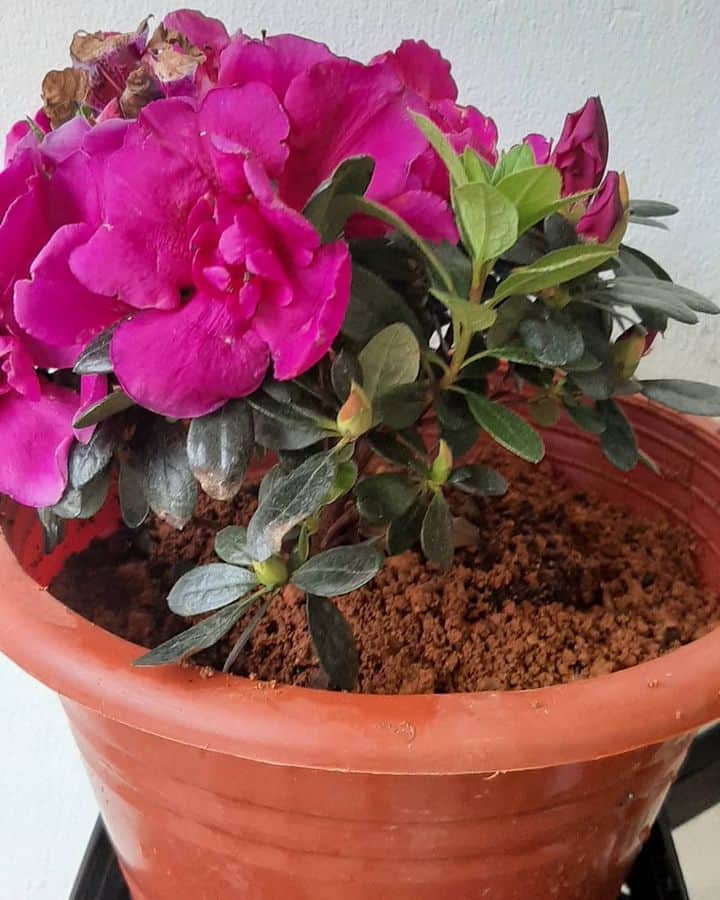Are your Azaleas suddenly starting to produce small leaves and flowers while exhibiting stunted growth?
Beware, it could be suffering from nutrient deficiency.
Scrolling down the screen, find a specific schedule to fertilize your Azaleas for the best yields.
Table of Contents Show
What is the Best Time to Fertilize Azaleas?
Azaleas are perennial flowering shrubs that bloom every spring when provided with the optimal growing conditions and correct plant food.
However, they do not demand continuous fertilization like other flowering plants; just once or twice a year would suffice.

Don’t fertilize Azaleas and Rhododendrons in the fall and winter, as the plants enter dormancy and cannot absorb the nutrients.
Fact: Do you know North Carolina falls in the USDA Zones 6a-8a, and spring is when the flower buds of Azaleas turn into stunning blooms?
Remember to apply the liquid formula in spring to give it a quick boost and resort to slow-release fertilizer in fall to supply slow yet steady nutrients.
For newly planted Azaleas, it’s best to wait until they have become established before fertilizing, which can take up to a year.
Similarly, you should prune them once the current bloom fades in summer, which may affect next year’s flowers.
You can remove spent flowers, yellowed or wilted leaves, and overgrowing branches.
What is the Best Fertilizer for Azaleas?
Azaleas are not very picky about nutrient boost and hardly grow over 3 feet indoors, requiring all-purpose plant food once to twice a year.
However, Azaleas demand more nitrogen than other nutrients because the nitrogen content often runs out of soil quickly.
Keep the phosphorus low to avoid harming the shallow roots.
Here are two different ways to meet their nutrient requirements.
1. Organic Fertilizers
Also known as slow fertilizers, organic fertilizers release nutrients slowly to improve soil texture and water-holding capacity.
Also, cottonseed and coffee grounds are best to fertilize Azaleas.
Follow this guide to create and apply an all-purpose organic fertilizer.
- Mix kitchen waste such as vegetable scraps, eggshells, and coffee grounds with a layer of dry materials such as leaves, shredded newspaper, or straw to the bin to balance the moisture and provide carbon.
- Keep the compost moist and turn it on regularly to speed up the decomposition process.
- Once the compost is dark and crumbly, it is ready to use as a fertilizer.
- Spread the mulch around the base of the plant without touching the stem or foliage, and water thoroughly afterward.
Otherwise, create a formulated fertilizer for nitrogen-deficient Azaleas.
- Mix one part fresh grass clippings with one part dried leaves in a bucket or container.
- Add water to the mixture until it is moist but not soaking wet.
- Cover the container with a lid or plastic wrap and place it in a warm, sunny spot for several weeks: stir the mixture occasionally to help speed up the decomposition process.
- After a few weeks, the mixture should start to break down and turn into a dark, rich liquid. Mix well and dilute the fertilizer with water, using a ratio of one part fertilizer to 10 parts water (1:10).
- Apply it directly to the soil around the base of your plants and water it thoroughly.
2. Commercial Fertilizers
You should be careful about using cheap synthetic fertilizers that cause soil toxin buildup.
Here are a few best fertilizer recommendations for Azalea plants.
| Product | Specificaiton |
|---|---|
| Miracle-Gro Water Soluble Azalea | The all-purpose fertilizer helps acid-loving plants attain great height, width, lush foliage, and flowering. |
| R Peter’s 77020 Jack’s Professional Geranium 15-15-15 | The all-purpose fertilizer is appropriate for plants like azaleas as it provides balanced nutrients and minimizes nutrient toxicities. |
| Dr. Earth Acid Lovers | The only non-GMO project verified fertilizer that is safe for use and is enriched with multi-minerals, proteins, and humic acids. |
| Espoma Organic Holly-tone 4-3-4 Natural & Organic Evergreen & Azalea Plant Food | A perfect fertilizer for acid-loving plants provide a rich blend of finest natural and orgnaic ingredients and is environmentally safe. |
Add about one teaspoon of fertilizer to 1 gallon of water and mix well before applying directly to the soil.
Editor’s Note
When Azaleas fail to bloom, diagnose the problems with sunlight, soil pH, plant food, and root rot due to overwatering to find a reliable solution.
You can maintain producing healthy Azalea blossoms every spring by optimizing the growing conditions and appropriate plant foods.


